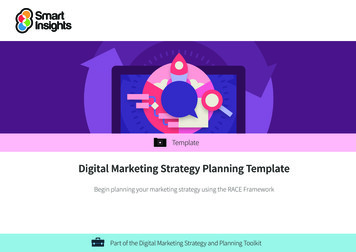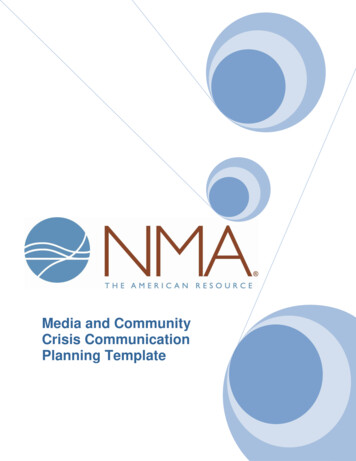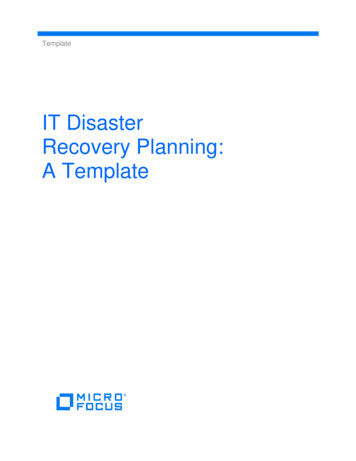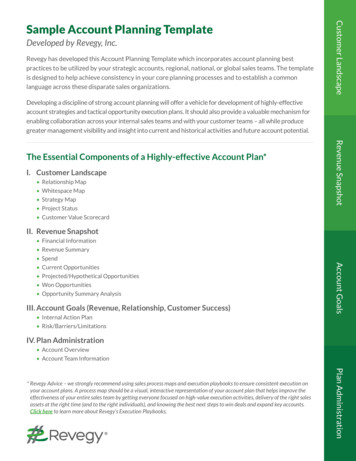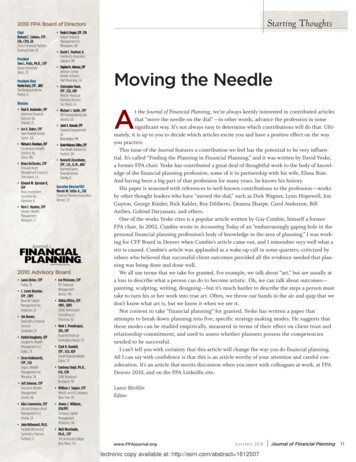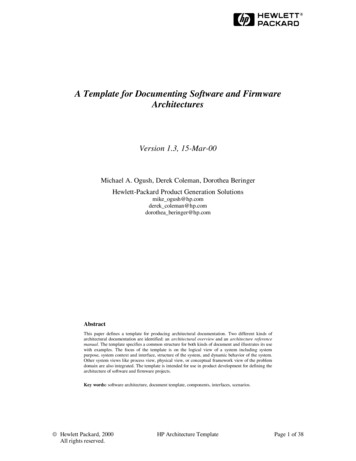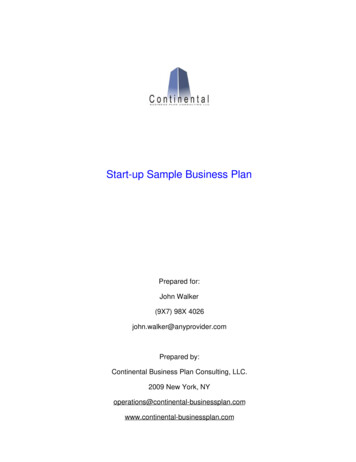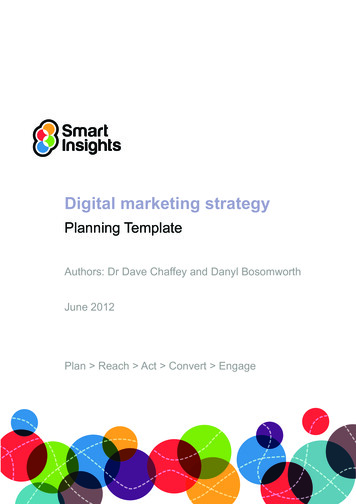
Transcription
Digital marketing strategyPlanning TemplateAuthors: Dr Dave Chaffey and Danyl BosomworthJune 2012Plan Reach Act Convert Engage
Digital Marketing Planning hanks for downloading this Smart Insights template. This is a sample of a wider selectionof our advice for marketers including 7 Steps Ebooks; online training courses; how-to-videosand marketing toolkits. See the full range of content used by our Expert members.First things, first.þþ Start with the customer. Build your plan around customer insights and needs - notaround your products and tactics.StrategySome general advice to keep in mind when planningObjectivesDigital marketing planning is no different to any other marketing plan, in fact it’s increasinglystrange to have separate plans for ‘digital’ and ‘offline’ since that’s not how your customersperceive your business. However, we’re often required to separate plans for “digital” onlybased on the way teams and reporting is structured and to help the transition to digital before it becomes “business as usual”. A common format helps align your plan to othermarketing plans!þþ Keep it flexible. Situations and plans change, especially online, so ensure plans areusable by a clear vision for the year and keeping detail to a shorter term 90-day focusþþ There isn’t a perfectplan. What’s neededchanges according toeach business!2Digital marketing planning template Smart Insights (Marketing Intelligence) Limited. Please go to www.smartinsights.com to feedback or access our other guides.!Executive summaryþþ Keep plans up todate. Review andupdate monthly orquarterly.Actions and controlsþþ Keep it Simple!“Jargon light” is best.Again it helps othersbuy into what you’resayingTacticsþþ Set realistic goals. Include specific objectives in your plans but keep them realistic byfact-based and stateassumptions, sothey’re easy for othersto buy into.
Creating a structure for your planKnowing where to start is often the hardest thing when writing a digital marketing plan. Soonce you have a structure / framework to follow in a table of contents, it’s then almost amatter of filling in the gaps.SOSTAC gives a great framework for business, marketing or digital marketing planssince it’s simple and logical, so it’s easy to remember and to explain plans to colleaguesor agencies. Each of the six areas help in separating out the key strategies, for examplecustomer acquisition, conversion and retention.SituationThat’s the intro, you’ll want to delete this bit! In the other sections we have provided headingsto help structure your strategy, with prompts to help your thinking in italics which you’ll alsowant to delete.1IntroductionAt Smart Insights we recommend the SOSTAC planning structure developed by PR Smith,Dave Chaffey’s co-author on Emarketing Excellence.Expert members can download an editable Word template as part of our Digital StrategyToolkit which includes Powerpoint, Word and Excel templates to help build your marketingplan and explain to colleagues or clients.If you’re not familiar with some of the concepts we introduce in this template, naturally,there’s more info online. We’ve created 200 free Quick Guides to introduce the basicconcepts. You can access these in our sitemap covering all the main areas of digitalmarketing practice.StrategyExpert members also get access to more detailed downloadable Ebook guides. We’vedesigned these to be quick to use with each varying from 50-100 pages in length withemphasis on the main strategy recommendations, quick win tips and examples in eachsection.ObjectivesWhere do I find more information on digital marketing concepts?7 Steps to success guides on digital marketing strategyþþ Digital marketing strategyTacticsThese are designed for to help those responsible for marketing to help create or refine anintegrated digital strategy and roadmap plan:þþ Delivering results from digital marketingBrowse all 7 Step guides7 Steps to success guides to get better results from digital channelsþþ Search engine Optimisationþþ Google Adwordsþþ Social media marketingþþ Improving results from your website and Landing page conversionþþ Email marketingþþ Google AnalyticsBrowse all 7 Step guides3Digital marketing planning template Smart Insights (Marketing Intelligence) Limited. Please go to www.smartinsights.com to feedback or access our other guides.!Executive summaryFocused on improvement, these guides are for marketers managing the details of digitalto ask the right questions of colleagues or agencies about how to get better results. Theyinclude:Actions and controlsþþ Content marketing strategy guide
The Smart Insights RACE frameworkOur RACE framework is designed to help create and refine digital marketing plans.Use the interactive version online to navigate our Quick Guides at ctivesStrategyTacticsActions and controlsExecutive summary4Digital marketing planning template Smart Insights (Marketing Intelligence) Limited. Please go to www.smartinsights.com to feedback or access our other guides.!
Situation analysis.IntroductionWhere are we now?Understanding your online marketplaceThe immediate, or micro-environmentA. Our customersAlways start with the customer, their characteristics, behaviours, needs and wants. Youshould define:B. Our marketC. Our competitorsþþ Benchmark against competitors for your customer personas and scenarios against thecriteria given in the strategy section, in particular their marketing mix.Strategyþþ Market description - Focus on actionable needs and trends - are you meeting them, whatare they - this insight us useful for other teams and you should find out what other teamsknow, what exactly is growing in the market, is there evidence you can draw fromObjectivesþþ Ideal customers - characteristics summarised in named personas are useful to getstarted, think about demographics, searching and product selection behaviours andunmet needs - detail here is very useful to talk about “What would John do. or thinkabout.”. Also consider what your data tells you in regard to your most profitable, andpotentially profitable customers2Situationþþ Options for segmenting and targeting – you should apply your traditional segments, butalso consider the new micro-targeting options available online –see http://bit.ly/smarttargeting.þþ For key digital tactics like SEO and social media marketing, it’s also important tobenchmark against competitors. See our digital marketing strategy guide.þþ Review customer use of different types of publisher or media sites which may influencetheir decision for example, search engines, specialist news sites, aggregators, socialnetworks and bloggersE. Wider macro environmentþþ Social - how have consumer attitudes changed?þþ Legal - checking your online marketing activities comply with privacy and online tradinglaws before problems ariseþþ Environment - is your approach ethical and sustainableþþ Political - can you take advantage of government funding schemesþþ Technology - review of the latest technology5Digital marketing planning template Smart Insights (Marketing Intelligence) Limited. Please go to www.smartinsights.com to feedback or access our other guides.!Executive summaryThese are the big picture strategic influences. We recommend you don’t go into too muchdepth on these, instead review the influence of the main macro factors for digital; social, legaland technology in the context of customer analysis and competitor benchmarking.Actions and controlsYou can monitor your reputation across different influencers - see our social media marketingguide.TacticsD. Intermediaries, influencers and potential partners
F. Our own capabilitiesOnce you have looked outwards (often missed), only then should you turn inwards and lookat your own capabilities.IntroductionIn particular, you may find this in-depth digital marketing benchmarking audit spreadsheet(Expert members) useful for benchmarking your current capabilities. There are also auditspreadsheets available for SEO and Email marketing. Basic members can use the simplerfree digital marketing health check.G. Internet-specific SWOT summarySituationInclude a digital channel SWOT that summarises your online marketplace analysis findingsAND links to strategy. In a large organisation, or for a more complete summary complete aSWOT for:þþ Customer acquisition and conversion and customer developmentþþ Different brandsþþ Different marketsþþ Different competitors – direct and indirect3ObjectivesWe recommend using a TOWS matrix for SWOT: http://bit.ly/smartswot since this helpsintegrate your analysis with your strategy rather than the analysis being placed on the shelfand forgotten.Tips2) Set-up your digital listening post to ensure you understand what’s going on around you andlisten in on conversation that could inform your understandingTactics3) Google “market research” for documents relevant to your sector, they’re often a cheapsource of insight to change perspectiveStrategy1) Garner evidence and data to help others understand your recommendations - visualise withcharts and graphs where you can – they’re much more effective than a long reportActions and controlsExecutive summary6Digital marketing planning template Smart Insights (Marketing Intelligence) Limited. Please go to www.smartinsights.com to feedback or access our other guides.!
Objective settingIntroductionWhere do we want to be?Setting useful, actionable objectivesWe recommend four different types of measures to help you and colleagues look forward tothe future offered by digital marketing:So we suggest this hierarchy of measures may help in larger organisations:Situationþþ 1. Top-level broad goals to show how the business can benefitfrom digital channelsþþ 2. Mid-long term vision to help communicate the transformation needed in a largerorganisationþþ 3. Specific SMART objectives to give clear direction and commercial targetsþþ 4. Key performance indicators to check you are on trackObjectivesYou should be as specific as possible in your goals. We recommend these should be:þþ SMARTþþ Based around the customer lifecycle – we use the mnemonic RACE to define this andgive a full list of KPIs in our digital marketing toolkit for Expert members.þþ Divided into key digital strategy areas of customer acquisition, conversion, customerdevelopment and growth - this is important to ensure you’re covering all of the areas4Strategyþþ Define what the R is in ROI for you - it will likely be monetary but don’t forget digitalmarketing can be more than thatþþ Broken down into short, medium and long-term goalsAlign goals to the business and marketing goals and how you substantiate them using theapproach described in our improving results from digital marketing ebook.TacticsTips2. Once you have completed the KPIs, go back up to the big picture and define a long-termvision for how digital will help the organisation grow into the future, again aligned withorganisational vision.4. Finally, remember to revisit this section to align with your control and review process.Simplify to the “strategic levers” which really control business results. These are your K KPIs.In a nutshell, it’s about alignment and integration between the different sections of your plan.7Digital marketing planning template Smart Insights (Marketing Intelligence) Limited. Please go to www.smartinsights.com to feedback or access our other guides.!Executive summary3. When creating the strategy make sure it is aligned with these goals, a table linking goals,substantiation (situation analysis) and strategies as given in Dave’s books can help here.Actions and controls1. Make sure your online goals align with organisational goals - your colleagues will believemore in your strategy then.
StrategyIntroductionHow are you going to achieve the goals?Setting a meaningful strategyThe key elements of digital strategy involve revisiting and aligning the main thrust of yourmarketing strategy in an online context, make sure you draw from other plans, if there isn’tone then use these headers. Don’t get drawn into the details at this stage. That’s the tactics.SituationWe recommend you summarise your strategy in a table like the one shown here: http://bit.ly/smartintegration - this provides a great summary and integrates goals with situation, strategy,tactics and measures!But you may want to summarise the essence of some or all of the digital strategies below.How are you going to leverage the potential of digital marketing to your business, and howdoes that meet the objectives? This is about your approach only, not the detail.ObjectivesConsider breaking it down as well, it’s often easier to explain in smaller, bite-size chunks, thisalso helps when it comes to tactics which should hang from the strategies below:A. Targeting and segmentationþþ Specific targeting approaches to apply online include: demographic, value-based,lifecycle and behavioural personalisation.4Strategyþþ A company’s online customers have different demographic characteristics, needs andbehaviours to its offline customers. It follows that different approaches to segmentationmay be required and specific segments may need to be selectively targeted thoughspecific content and messaging on your site or elsewhere on the web. This capability for“micro-targeting is one of the biggest benefits of digital marketing.B. Positioningþþ How do you position your online products and services in the customers mind? Considerþþ Define your online value proposition. This should flow from your positioning and be whatthe customer sees immediately when they interact with you online.þþ You need clear messaging hierarchies to effectively communicate your positioning both inonline and offline media.C. Proposition and the marketing mixFor example:þþ Product. Can you offer a different product range online? How can you add value toproducts through additional content or online services?þ
Digital marketing planning template 3 1 Creating a structure for your plan Knowing where to start is often the hardest thing when writing a digital marketing plan. So once you have a structure / framework to follow in a table of contents, it’s then almost a matter of filling in the gaps.

